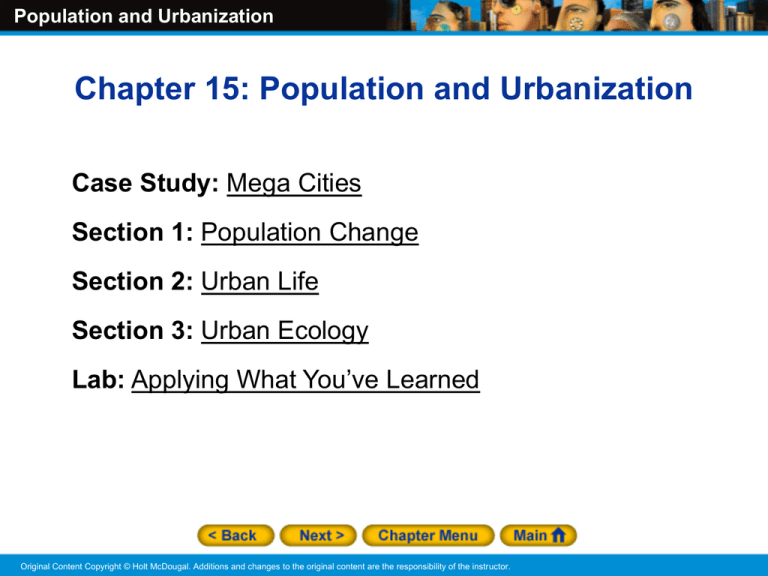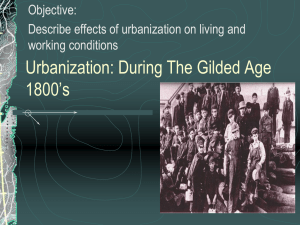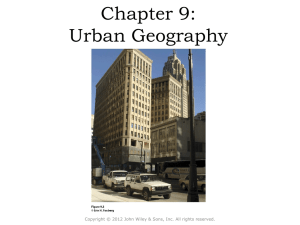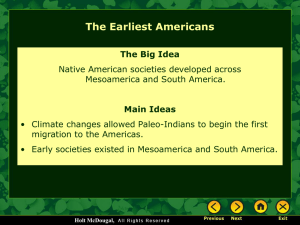
Population and Urbanization
Chapter 15: Population and Urbanization
Case Study: Mega Cities
Section 1: Population Change
Section 2: Urban Life
Section 3: Urban Ecology
Lab: Applying What You’ve Learned
Original Content Copyright © Holt McDougal. Additions and changes to the original content are the responsibility of the instructor.
Population and Urbanization
Case Study: Mega Cities
Enormous cities such as São Paulo, Brazil, are considered
megacities, or urban areas with a population of more than
10 million. More than 280 million people live in the world’s
25 megacities. People flock to these cities for work, but
large population centers face challenges in providing
transportation, energy, health care, and law enforcement.
Original Content Copyright © Holt McDougal. Additions and changes to the original content are the responsibility of the instructor.
Population and Urbanization
Original Content Copyright © Holt McDougal. Additions and changes to the original content are the responsibility of the instructor.
Population and Urbanization
Section 1 at a Glance
Population Change
• Three factors affect the growth or decline of a region’s
population: the birthrate, the death rate, and the rate of
migration.
• In the late 1700s, Thomas Malthus predicted that
populations around the world would continue to grow
rapidly. His theory also stated that a rapidly growing
population would outpace food production, which would
cause famine.
Original Content Copyright © Holt McDougal. Additions and changes to the original content are the responsibility of the instructor.
Population and Urbanization
Section 1 at a Glance (cont.)
Population Change
• Because the demographic transition theory considers a
society’s level of technological development, most
demographers favor that theory to the Malthusian theory.
• Many countries around the world have adopted strategies
aimed at controlling their population, such as family
planning and economic improvements.
Original Content Copyright © Holt McDougal. Additions and changes to the original content are the responsibility of the instructor.
Population and Urbanization
Population Change
Main Idea
• The world’s population is constantly changing. Demographers study
these changes and apply theories to explain them.
Reading Focus
• How do demographers study world population change?
• What theories attempt to explain population change?
• Why do some countries want to control population growth?
Original Content Copyright © Holt McDougal. Additions and changes to the original content are the responsibility of the instructor.
Population and Urbanization
A Baby-less Society?
Why are the
populations of some
countries falling?
Original Content Copyright © Holt McDougal. Additions and changes to the original content are the responsibility of the instructor.
Population and Urbanization
World Population Change
The rapid population
growth of recent years
has had a tremendous
effect on social life.
Population: number of
people living in an area
at a particular time
Demography: the study
of human populations
Original Content Copyright © Holt McDougal. Additions and changes to the original content are the responsibility of the instructor.
Population and Urbanization
World Population Change
Birthrate
• Annual number of live births per 1,000 members of a
population
• U.S. rate is 14.6
• Fertility: number of births occurring to women of
childbearing age
• Fecundity: biological capability to bear children. Women
have the biological capacity to bear between 15 and 30
children, but most women reproduce far fewer than that
number.
Original Content Copyright © Holt McDougal. Additions and changes to the original content are the responsibility of the instructor.
Population and Urbanization
World Population Change
Death Rate
• Annual number of deaths per 1,000 members of a population
• U.S. rate is 8.5
• Various kinds of death can be calculated to more accurately
depict a society’s death rate.
• Infant mortality rate: number of death among infants under
one year of age per 1,000
• Industrialized countries have a much lower infant mortality
rate.
• Life expectancy: average number of years that a person born
in a particular year can expect to live
Original Content Copyright © Holt McDougal. Additions and changes to the original content are the responsibility of the instructor.
Population and Urbanization
World Population Change
Migration Rate
• Migration: the movement of people from one area to
another
• Migration rate: annual number of people who move into a
specified area per 1,000 members of that area’s population
• Push factors: factors that encourage people to move out of a
place. Examples: persecution, famine, racial discrimination,
overpopulation
• Pull factors: factors that encourage people to move into a
place. Examples: religious and political freedom, economic
opportunities, high standard of living
Original Content Copyright © Holt McDougal. Additions and changes to the original content are the responsibility of the instructor.
Population and Urbanization
Growth Rate
Population Composition
• The rate at which a country’s
population is increasing
•
The structure of a population
•
Age and sex are the factors most
often used to show the
composition of a population.
•
Population pyramid: graphic
representation of the age and sex
distribution of a population
•
Demographers use population
pyramids to help make predictions
about future population needs
such as health care.
• Calculated by subtracting the death
rate from the birthrate and usually
expressed as percentages
• U.S. rate is 0.6 percent, meaning
that about 6 people were added to
the population for every 1,000
members
• Growth rates in more-developed
countries are typically lower.
• A population growth rate of only 1
percent will cause that population
to double in size in about 70 years.
Original Content Copyright © Holt McDougal. Additions and changes to the original content are the responsibility of the instructor.
Population and Urbanization
Original Content Copyright © Holt McDougal. Additions and changes to the original content are the responsibility of the instructor.
Population and Urbanization
Original Content Copyright © Holt McDougal. Additions and changes to the original content are the responsibility of the instructor.
Population and Urbanization
Reading Check
Summarize
What three factors affect a region’s growth
or decline in population?
Answer: birthrate, death rate, and migration rate
Original Content Copyright © Holt McDougal. Additions and changes to the original content are the responsibility of the instructor.
Population and Urbanization
Explaining Population Change
Malthusian Theory
• Thomas Malthus proposed that population grew
geometrically, and would therefore outstrip the ability to
feed everybody.
• Two checks on population:
•
Preventative—lowering birth rate (birth control)
•
Positive—increasing death rate (war)
• Malthus failed to foresee advances in agriculture
production and acceptance of birth control.
Original Content Copyright © Holt McDougal. Additions and changes to the original content are the responsibility of the instructor.
Population and Urbanization
Explaining Population Change
Demographic Transition Theory
• Population patterns are tied to a society’s level of
technological development.
• Stage 1: Preindustrial: birth rate and death rate high;
fairly stable population
• Stage 2: Developing industrial: reduced death rate and
high birthrate; rapidly growing population
• Stage 3: Developed industrial: reduced birthrate and low
death rate; fairly stable population
Original Content Copyright © Holt McDougal. Additions and changes to the original content are the responsibility of the instructor.
Population and Urbanization
Original Content Copyright © Holt McDougal. Additions and changes to the original content are the responsibility of the instructor.
Population and Urbanization
Reading Check
Identify Cause and Effect
What happens to a population if the birthrate
is lower than the death rate?
Answer: The population will decrease over time.
Original Content Copyright © Holt McDougal. Additions and changes to the original content are the responsibility of the instructor.
Population and Urbanization
Controlling Population Growth
The world now contains nearly 6.2 billion people, and the
population continues to grow. Concerns about rapid growth have
led to strategies aimed at controlling this growth.
Family Planning
Economic Improvements
• The conscious decision by
couples to have a certain
number of children
• Some critics of family-planning
believe that economic
development must proceed
before people in less-developed
nations will voluntarily limit
family size.
• Involves using birth control
• Some countries offer incentives
for small families, such as
placing fines on additional
children.
Original Content Copyright © Holt McDougal. Additions and changes to the original content are the responsibility of the instructor.
Population and Urbanization
Reading Check
Draw Conclusions
How are some nations controlling population
growth?
Answer: family planning, programs to promote
economic development
Original Content Copyright © Holt McDougal. Additions and changes to the original content are the responsibility of the instructor.
Population and Urbanization
Section 2 at a Glance
Urban Life
• Some sociologists study ways that the movement of
populations affects the social world, especially the
movement called urbanization. This movement involves
the concentration of the population in cities.
• Cities first arose about 6,000 years ago on the fertile
banks of major rivers in North Africa and Asia. Many of
these early cities were small by modern standards and
contained a few thousand people. Most preindustrial
cities were very crowded and lacked any kind of
sanitation system. As a result, death rates in cities were
higher than those in rural areas.
Original Content Copyright © Holt McDougal. Additions and changes to the original content are the responsibility of the instructor.
Population and Urbanization
Section 2 at a Glance (cont.)
Urban Life
• The industrial city was much larger than the preindustrial
city, and commerce was the focal point of urban life. For
the first time in history, people worked outside of the
home in offices and factories. As industrial cities grew
larger, crime, overcrowding and pollution increased.
Original Content Copyright © Holt McDougal. Additions and changes to the original content are the responsibility of the instructor.
Population and Urbanization
Urban Life
Main Idea
Cities have evolved through time, and face many challenges today.
Reading Focus
• How did cities evolve?
• What are some of the challenges cities face today?
Original Content Copyright © Holt McDougal. Additions and changes to the original content are the responsibility of the instructor.
Population and Urbanization
The Past Revisited
Do you think you could
live in a city without a
car?
Original Content Copyright © Holt McDougal. Additions and changes to the original content are the responsibility of the instructor.
Population and Urbanization
The Evolution of the City
Urbanization is the concentration of the population into cities. A
city is a permanent concentration of a relatively large number of
people who are engaged mainly in nonfarming activities.
The Preindustrial City
The Industrial City
• The first cities arose about
6,000 years ago and grew
because of advances in
agriculture.
• The Industrial Revolution
changed life in the cities.
• Life in early cities was
crowded and dirty.
• Commerce and society
became the focal point of life
instead of the family.
• Mechanization of agriculture
led people to move to cities.
Original Content Copyright © Holt McDougal. Additions and changes to the original content are the responsibility of the instructor.
Population and Urbanization
Click on the image to play the Interactive.
Original Content Copyright © Holt McDougal. Additions and changes to the original content are the responsibility of the instructor.
Population and Urbanization
Original Content Copyright © Holt McDougal. Additions and changes to the original content are the responsibility of the instructor.
Population and Urbanization
Reading Check
Contrast
How did the industrial city differ from
the preindustrial city?
Answer: The industrial city was larger in area and
population. Central business districts replaced parts of
the city devoted to certain trades. People worked
farther away from where they lived, and the family
became a less powerful force in controlling the daily
life of the individual.
Original Content Copyright © Holt McDougal. Additions and changes to the original content are the responsibility of the instructor.
Population and Urbanization
Urban Challenges Today
• Urbanization in more-developed countries has usually
resulted in increased rates of literacy, greater economic
opportunities, and improved health care.
• Urbanization in less-developed countries has been less
orderly and more rapid.
• Overurbanization: a situation in which more people live
in a city than can be supported in terms of jobs and
facilities.
– Inadequate housing, food, sewage disposal, and hospitals
– High rates of illness and death
Original Content Copyright © Holt McDougal. Additions and changes to the original content are the responsibility of the instructor.
Population and Urbanization
Reading Check
Draw Conclusions
How do you think overurbanization
can be prevented?
Answer: Possible answer—Create more job
opportunities for people in areas outside of cities
so they will not be drawn into urban areas to find
work or services
Original Content Copyright © Holt McDougal. Additions and changes to the original content are the responsibility of the instructor.
Population and Urbanization
Cultural Diversity and Sociology
New York City’s Ethnic Neighborhoods
Centuries of migration and immigration have shaped New York
City into hundreds of distinct ethnic neighborhoods that have
come to reflect the diverse cultures of these immigrants.
• Lower East Side: large population of Jews, home of the city’s
first synagogue
• Chinatown: street signs in both English and Chinese, Chinese
groceries and restaurants
• Jackson Heights: “Little India,” Bollywood theaters and Indian
restaurants, also home to immigrants from Latin America,
Eastern Europe, and Russia
Original Content Copyright © Holt McDougal. Additions and changes to the original content are the responsibility of the instructor.
Population and Urbanization
Cultural Diversity and Sociology
New York City’s Ethnic Neighborhoods
Centuries of migration and immigration have shaped New York
City into hundreds of distinct ethnic neighborhoods that have
come to reflect the diverse cultures of these immigrants.
• Little Italy: not as Italian as it used to be, now more of a tourist
destination. Many Italians have moved to Staten Island.
• Harlem: center of African American culture and music in the
1920s, recent economic revitalization
• Spanish Harlem: high concentration of Puerto Ricans
• Irish New York: about 2 million migrated in mid-1800s
Original Content Copyright © Holt McDougal. Additions and changes to the original content are the responsibility of the instructor.
Population and Urbanization
Original Content Copyright © Holt McDougal. Additions and changes to the original content are the responsibility of the instructor.
Population and Urbanization
Cultural Diversity and Sociology
Thinking Critically
• How do New York’s ethnic neighborhoods differ?
• What influence do you think immigrants have on the city’s
culture?
Original Content Copyright © Holt McDougal. Additions and changes to the original content are the responsibility of the instructor.
Population and Urbanization
Section 3 at a Glance
Urban Ecology
• Some sociologists developed urban ecology as an
approach to studying cities. This approach examines the
relationship between people and the urban environment.
• In addition to studying the structure of cities, sociologists
are interested in the nature of life in cities. Several
theories try to explain city life—urban anomie,
compositional, and subcultural.
Original Content Copyright © Holt McDougal. Additions and changes to the original content are the responsibility of the instructor.
Population and Urbanization
Urban Ecology
Main Idea
Researchers have created several models to explain the structure of
cities and several theories to explain city life.
Reading Focus
• What models of city structure are there?
• How do some theories explain city life?
Original Content Copyright © Holt McDougal. Additions and changes to the original content are the responsibility of the instructor.
Population and Urbanization
How are cities
helping to protect
the environment?
Original Content Copyright © Holt McDougal. Additions and changes to the original content are the responsibility of the instructor.
Population and Urbanization
Models of City Structure
Urban ecology examines the relationship between people and the
urban environment.
– Human behavior determines the layout of the urban environment,
and in turn the urban environment affects human behavior.
– Areas of a city are created for set purposes, and as a result,
people, buildings, and activities are distributed in certain patterns.
Concentric Zone Model
• A typical industrial city spreads outward from the center, resulting in a
series of circles or zones.
• Each zone used differently
• Residential areas constantly changing
• Geographical features might change structure
Original Content Copyright © Holt McDougal. Additions and changes to the original content are the responsibility of the instructor.
Population and Urbanization
Models of City Structure
Sector Model
• Growth occurs in wedge-shaped sectors—not concentric circles—
outward from the center to the edge of the city.
• Transportation routes shape city.
Multiple Nuclei Model
• A city grows outward from several centers of activity (nuclei), not just
one.
• Addresses use of automobile in cities
• Clustering occurs because it is beneficial: several stores grouped
together will attract more customers than one single store.
Original Content Copyright © Holt McDougal. Additions and changes to the original content are the responsibility of the instructor.
Population and Urbanization
Original Content Copyright © Holt McDougal. Additions and changes to the original content are the responsibility of the instructor.
Population and Urbanization
Urban Ecology Models—A Critique
• These three models describe ideal city growth conditions
and are not expected to be exact reflections of any one or all
urban areas.
• They account for previous trends, such as suburbanization,
but not some recent trends, such as urban sprawl.
– Urban sprawl: poorly planned development on the edge of
cities and towns
• Downtown residential areas are proposed to be low-income
in these models, but in reality downtown areas have become
high-income residential areas.
• Ignore emotional ties of a population to a particular location.
Original Content Copyright © Holt McDougal. Additions and changes to the original content are the responsibility of the instructor.
Population and Urbanization
Reading Check
Summarize
What are the models of city structure?
Answer: concentric zone, sector, multiple nuclei
Original Content Copyright © Holt McDougal. Additions and changes to the original content are the responsibility of the instructor.
Population and Urbanization
Theories of City Life
Urban Anomie Theory
• Anomie means “normlessness.”
• Theory proposed by Louis Wirth.
• The city is an anonymous and unfriendly place, and
living there carries serious negative consequences for
residents.
• Cities discourage primary group relationships. This
lack of primary relationships produces anomie.
• Contact with others is short-lived, formal, and shallow.
Original Content Copyright © Holt McDougal. Additions and changes to the original content are the responsibility of the instructor.
Population and Urbanization
Theories of City Life
Compositional Theory
• The composition of a
city’s population
influences city life.
• Age, race, ethnicity,
education, income, and
occupation affect urban
lifestyle.
• Five identifiable
lifestyles among city
dwellers
Subcultural Theory
• Characteristics of the
city encourages primary
group relationships.
People form groups
around interests.
• Because of the city’s
size and diversity,
people can find others
who share their interests
and lifestyles.
Original Content Copyright © Holt McDougal. Additions and changes to the original content are the responsibility of the instructor.
Population and Urbanization
Original Content Copyright © Holt McDougal. Additions and changes to the original content are the responsibility of the instructor.
Population and Urbanization
Reading Check
Explain
How does the subcultural theory describe
the formation of relationships?
Answer: Since there are many people in cities
who might share one’s interests, there are also
more opportunities to form associations and
friendships with people.
Original Content Copyright © Holt McDougal. Additions and changes to the original content are the responsibility of the instructor.
Population and Urbanization
Lab: Applying What You’ve Learned
Analyzing World Population Statistics
How does the population of the United States differ from
the population of other countries?
1. Introduction
• In this lab, you will analyze
population statistics for the
United States and for another
country.
• Work in pairs to research a
country and find statistics for
both countries.
2. Compiling Statistics and
Creating a Poster
• Enter your statistics in a chart.
• Add your chart and a title to a
piece of poster board.
• Print the population pyramids you
found and add those.
• Finally, add photographs or
illustrations that explain the data.
Original Content Copyright © Holt McDougal. Additions and changes to the original content are the responsibility of the instructor.
Population and Urbanization
Original Content Copyright © Holt McDougal. Additions and changes to the original content are the responsibility of the instructor.
Population and Urbanization
Lab (cont.)
3. Presenting Your Poster
4. Discussion
• Work with your partner to
decide who will present which
parts of the poster.
• What did you learn from this
lab? As a group, discuss the
following:
• Talk about the following:
• What differences and similarities
among countries did you find?
• Statistics tables
• Population pyramids
• Comparing the two countries
• Explaining the illustrations
• Do you think the growth rate of a
country affects its society?
Explain.
• Which assigned country has the
lowest birthrate?
• Which assigned country has the
largest percentage of teenagers?
Original Content Copyright © Holt McDougal. Additions and changes to the original content are the responsibility of the instructor.









